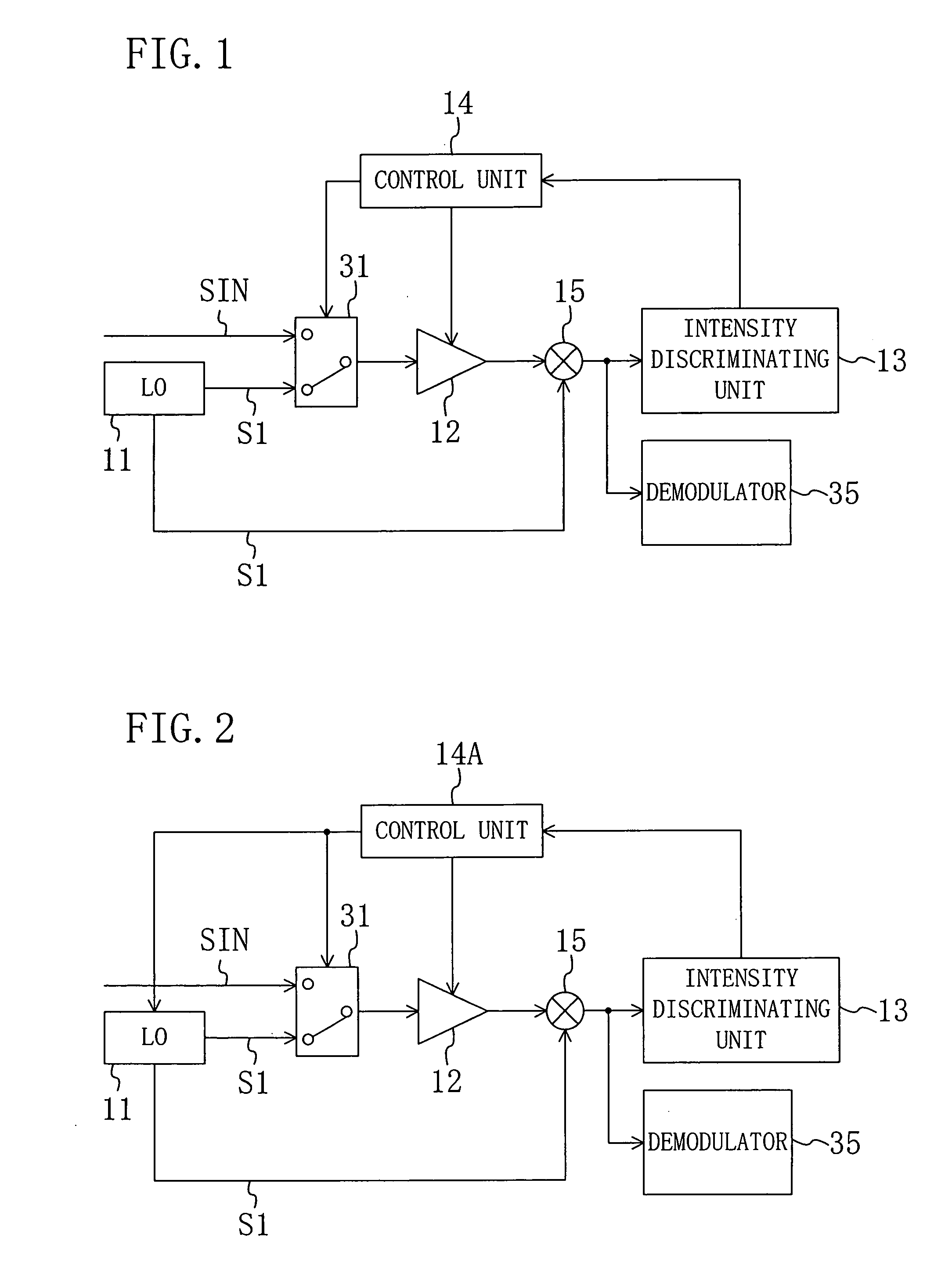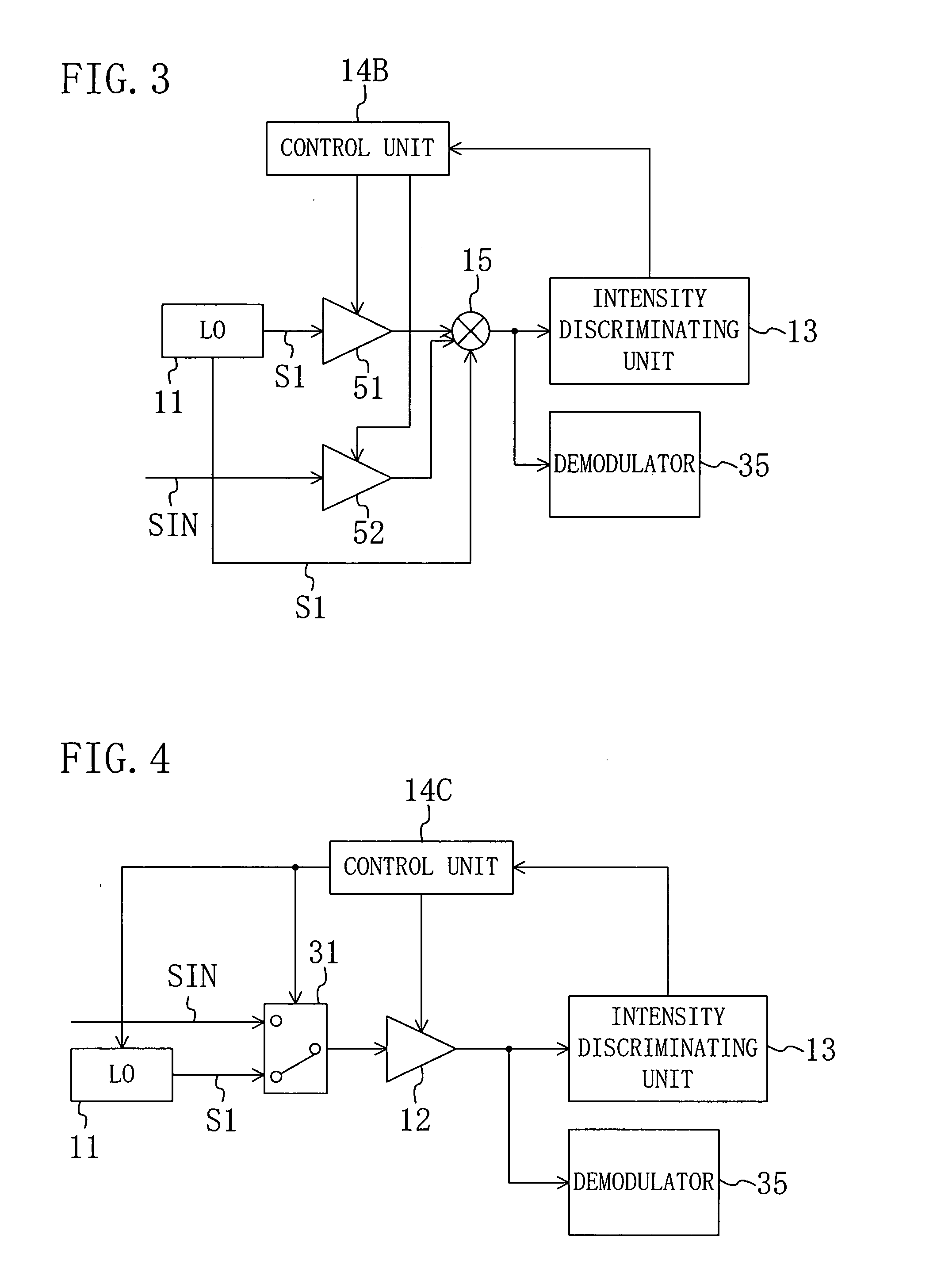Radio communication system
a communication system and radio technology, applied in the field of radio communication systems, can solve the problems of disadvantageous time-consuming and laborious to achieve synchronization for communication, and degrade communication performance, so as to improve communication performance, prevent the degraded communication performance, and shorten the time
- Summary
- Abstract
- Description
- Claims
- Application Information
AI Technical Summary
Benefits of technology
Problems solved by technology
Method used
Image
Examples
embodiment 1
[0027]FIG. 1 is a diagram for showing the architecture of a radio communication system according to Embodiment 1 of the invention. In FIG. 1, a reference numeral 11 denotes a local oscillator (LO), a reference numeral 12 denotes a low noise amplifier (LNA) capable of hopping a frequency band to be amplified, a reference numeral 13 denotes an intensity discriminating unit for discriminating signal intensity, a reference numeral 14 denotes a control unit for controlling a frequency band of the low noise amplifier 12, a reference numeral 15 denotes a mixer for integrating an oscillation output signal S1 of the local oscillator 11 and an output signal of the low noise amplifier 12, a reference numeral 31 denotes a selection unit receiving an input signal SIN and the oscillation output signal S1 of the local oscillator 11 as inputs for selectively outputting one of them, and a reference numeral 35 denotes a demodulator for demodulating an output signal of the mixer 15.
[0028]The control u...
embodiment 2
[0034]FIG. 3 is a diagram for showing the architecture of a radio communication system according to Embodiment 2 of the invention. In FIG. 3, like reference numerals are used to refer to like elements shown in FIG. 1. As compared with the architecture of FIG. 1, first and second low noise amplifiers 51 and 52 each capable of hopping the frequency band to be amplified are provided in FIG. 3 instead of the low noise amplifier 12 and the selection unit 31. The first low noise amplifier 51 receives and amplifies an output signal S1 of a local oscillator 11. On the other hand, the second low noise amplifier 52 receives and amplifies an input signal SIN. A control unit 14B controls the amplification operations and the frequency bands of the first and second low noise amplifiers 51 and 52, and a mixer 15 integrates the output signal S1 of the local oscillator 11 and an output signal of the first or second low noise amplifier 51 or 52.
[0035]The operation of the radio communication system ha...
embodiment 3
[0041]In Embodiment 3 of the invention, the present invention is applied to a communication system in which frequency shift by using a mixer is not performed.
[0042]FIG. 4 is a diagram for showing the architecture of a radio communication system according to Embodiment 3 of the invention. In FIG. 4, like reference numerals are used to refer to like elements shown in FIG. 1. As compared with the architecture of FIG. 1, a mixer 15 is omitted, an intensity discriminating unit 13 discriminates the signal intensity of an output of a low noise amplifier 12, and a demodulator 35 receives and demodulates the output of the low noise amplifier 12 in the architecture of FIG. 4.
[0043]In employing the architecture of FIG. 4, in the communication system where no mixer is used, a pulse signal is once input to a band pass filter to select a frequency component and then output from an antenna on a transmitting side. On the other hand, for amplifying a signal received at an antenna on a receiving side...
PUM
 Login to View More
Login to View More Abstract
Description
Claims
Application Information
 Login to View More
Login to View More - R&D
- Intellectual Property
- Life Sciences
- Materials
- Tech Scout
- Unparalleled Data Quality
- Higher Quality Content
- 60% Fewer Hallucinations
Browse by: Latest US Patents, China's latest patents, Technical Efficacy Thesaurus, Application Domain, Technology Topic, Popular Technical Reports.
© 2025 PatSnap. All rights reserved.Legal|Privacy policy|Modern Slavery Act Transparency Statement|Sitemap|About US| Contact US: help@patsnap.com



